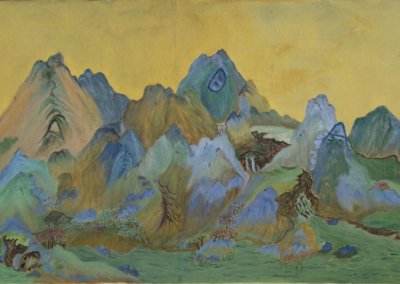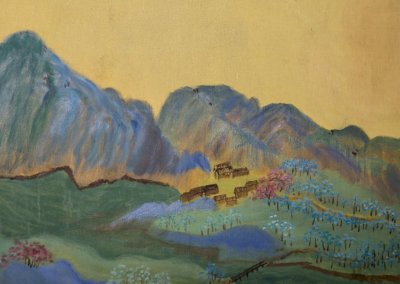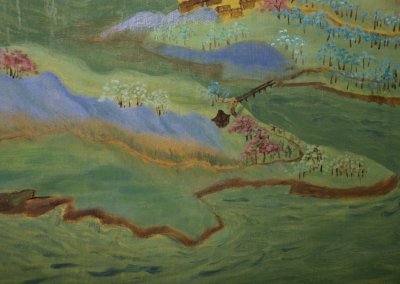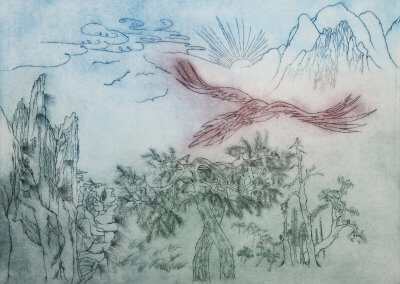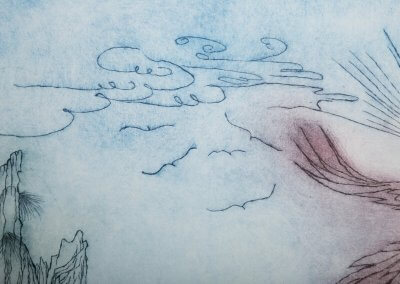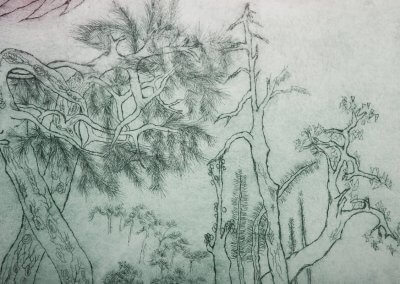
Gao Shunzen
1963, China.
Gao Shuzhen, born in Harbin Heilongjiang in 1963, is the member of Heilongjiang Artists Association, PhD in management and a retired banker. She began her traditional Chinese painting career in 2017 after her retirement.
In order to fully master the basic theories and methods of traditional Chinese painting, she attended the advanced flower and bird painting program held by China National Academy of Painting in Beijing in 2017 and graduated in 2018. She is attending a postgraduate program at Accademia D’arte Firenze in Italy and has finished the Italian painting history and style program. After a one–year study, she has gained a general understanding of western art. In particular, she has learned the basic methods of oil painting, printmaking, mural and sculpture in detail taught by Italian lecturers. She has created artistic works that embody her unique style with her own cultural background and personal characteristics. Meanwhile, she is also a postgraduate majoring in Chinese painting at Harbin Normal University in China.
She participated in the Ninth Exhibition for New Painting Works, New Painters and the Calligraphy and Painting Exhibition for Harbin Staff Members in 2018.
Her artistic ideal lies in the study of Chinese painting techniques and art creation. She introduces the theories and techniques of Western oil painting to Chinese brush ink painting by combining the Chinese line-focused characteristics with Western colour-rich one. She has been exploring the combination methods of Chinese and Western painting techniques so as to instruct personal artistic creation.
Gao Shuzhen develops his research in the field of painting, looking for and experimenting with a connection between the Chinese and Western European artistic tradition. After a specialization in Chinese painting technique, which includes canonical ways of representing nature and also the use of calligraphy within the composition – and therefore a different interpretation of the painting than that of modern and contemporary Western art (for over a century more focused on “how” than “what”, reflecting more on technical and stylistic possibilities than on the subject itself).
The artist’s current research attempts a combination through a mixture of genre and technique, which in some way we could consider a “translation”: that is, taking a typically Chinese landscape painting and interpreting it, respecting its figuration, with the use of a different technique, in the case of the great TITOLO painting in the exhibition, for example by using oil on canvas. On the other hand, in the case of the TITOLO painting, the passage has provided for the use of engraving.
In this transfer, from one technique to another, what is obtained goes beyond the practical aspect in itself: the formal substance is different, and changing it speaks to us of noble traditions that, over the centuries, have developed different visions of nature: that is, how it is seen, how it is considered, and how it is intended to be represented. A fruitful dialogue is thus established, allowing both sides to enrich themselves.
Splendid Mountains and Rivers
Size: 104.4*80CM Year: 2019
Inspiration and story of the painting
On my way to Italy for study, especially at the time when the airplane flew over the Alps in Europe, I was amazed with the stretching mountains catching my eyes. I grew up in the Northeast China, where forests are endless. In my childhood, I used to have fun in the mountains, so I have special love to the hills and trees.
Inspired by my old good days, I use oil painting skill I learned at school to create a traditional Chinese mountain-river painting. In doing so, I can also show my awe to the Mountain-Gods and deep love to nature.
The rolling mountains and winding rivers are all in my painting. The waterfall pours down from the top of the mountain to the river at the foot of the mountain. Along the river are dense trees and grass; the path is winding and rugged; the village is surrounded by mountains and rivers. The painting exhibits the skill that the spectator seems to be in the picture, lingering and rejoicing, and that is what the Chinese landscape painting features. Besides, the harmony between human and nature, and human and society has been conveyed through the painting.
Hereby I want to extend my gratitude to Accademia D’arte Firenze for offering me a chance to learn and better understand western painting and its skills, and for this, I ingeniously hide the name of the school in the lines of the painting to show that Accademia D’arte Firenze is integrated with my painting career and a wish for its great fame.
Skills in painting
In terms of mountain image, I adopt the traditional Chinese mountain brush ink skill. To draw the mountains, I apply pencil-outline skill of oil painting, Chinese flat colouring, and rhythm-like outlining . Besides, light and shade and other strokes are used to show the image of mountains.
When it comes to the color, it is the typical traditional Chinese landscape painting one, namely, blue and green. As it takes certain time for oil painting to let the dye dry, in the process of my drawing, I manage to utilize it to make different colors blend together and harmonize them and, finally, accomplish the work.
I believe the painting is exactly the example of how to integrate Chinese and Western drawing skills in an artistic creation.
A reborn eagle
Size: 180*70 CM Year: 2020
Inspiration and story of the painting
The inspiration is from a story. It is believed that an eagle has the longest lifespan among all the birds. However, to achieve that, the eagle has to overcome an indispensable challenge!
When the eagle grows 40 years old, its claws begin to get dull, thus unable to hunt preys as often as before; its beak gets long to the chest and bent; its wings get heavy as feathers get dense and thick, its flying becoming difficult.
Now the eagle is faced with a tough choice: waiting to die or getting through a painful period of 150 days to get reborn.This is what the eagle has to get through.
It has to fly hard onto the top of a mountain, nest, settle down on the cliff, and stop flying for 150 days, during which it keeps its beak hitting the rock until the old beak drops. After the new beak grows out, it uses the beak to pull up every single nail; after the new nails grows out, it uses the new nails to pull up all the feathers; with new feathers growing out in 5 months later, the eagle flies back to the sky, restarting another splendid life of 30 years.
Sometimes we humans, like an eagle, have to make a hard decision to update ourselves. In 2018, when I retired, I also faced a tough problem —- When my career came to an end, how did I start a new one?
At that time, I was haunted by a question, that was, since the life was limited, how to live a life that I would never regret? Finally, I decided to start a new career in the rest life. I had to say goodbye to the past whether it was glorious or painful! I learned a new skill to realize my wish. I set a goal to myself, that is, attempting to be an artist within10 years.
By painting, I use lines to communicate, sketches to record the moments in life, colors to convey emotions, and study to get myself updated—-it is what I desire myself to be, enthusiastic and appealing, just like a reborn eagle. So at the age of 55, I began my new career and ever since, I has been devoted to painting.
Skills in painting
Carving and printing skills of engraving painting learns from my tutor, Sonia, are applied. Meanwhile guided by my tutor, I borrow the hill-stone and tree pattern of Chinese ink painting and the powerful stroke of Chinese calligraphy to create this work.
An eagle, with its new feathers, beak and claws, facing the sun, flies back to the sky, overlooking the vast earth, across forest and grassland. I think I achieve the anticipated goal, my emotions conveyed by the theme of a reborn eagle.

